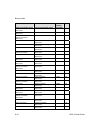
Binary to Hex
UDS-10 User Guide 10-1
10. IP Addresses
An IP address is a 32-bit value, divided into four octets of eight bits each. The standard
representation is four decimal numbers (in the range of 0..255) divided by dots.
192.2.1.123
This is called decimal-dot notation.
The IP address is divided in two parts: network and host. To support different needs, three
network classes have been defined. Depending on the network class, the last one, two or three
bytes define the host, while the remaining part defines the network. In the following
explanations, x stands for the host part of the IP address:
10.1 Class A Network
IP address 1.x.x.x to 127.x.x.x
Only 127 different networks of this class exist. These have a very large number of potential
connected devices (up to 16,777,216).
Example: 10.0.0.1, (network 10, host 0.0.1)
10.2 Class B Network
IP address 128.0.x.x to 191.255.xxx.xxx
These networks are used for large company networks. Every network can consist of up to
65,534 devices.
Example: 172.1.3.2 (network 172.1, host 3.2)
10.3 Class C Network
IP address 192.0.0.xxx to 223.255.255.xxx
These network addresses are most common and are often used in small companies. These
networks can consist of a maximum number of 254 hosts.
Example: 192.7.1.9 (network 192.7.1, host 9)
The remaining addresses 224.x.x.x - 239.x.x.x are defined as ”class D” and are used as
multicast addresses.
The addresses 240.x.x.x. - 254.x.x.x are defined as class E and are reserved addresses.


















